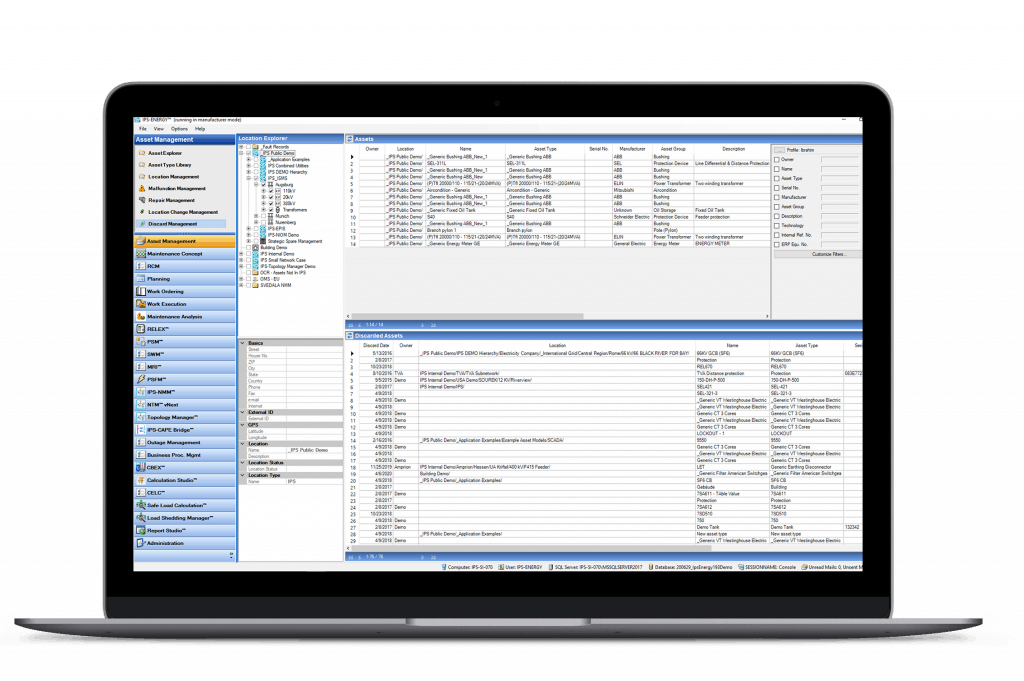Advanced Facility Ratings Management –
The new FERC 881 Order Solution within IPS® Portfolio
Supports Full Compliance with FERC Order 881

IPS® Advanced Facility Ratings Management (IPS®AFRM) is a newly developed solution that helps utilities meet all the requirements of FERC 881. It allows users to collect all rating information for all series devices and integrates weather data, which provides local weather information for accurate Ambient Adjusted Ratings.
ADVANCED FACILITY RATINGS MANAGEMENT
IPS®AFRM uses the connectivity defined in the network model to identify all electrically connected equipment to ensure accurate and transparent facility ratings. The system utilizes all established rating types for this equipment and includes calculated line limits imposed by the protection system. These rating types can be calculated on any needed time frame and utilizing any defined calculation for Base, Seasonal, AAR, or Emergency ratings using current and forecasted industry-recognized weather data.
IPS®AFRM is a CIM-based solution capable of dynamically responding to changes in the network model based on available data. It can intelligently process all dynamic and static data from the lines and within the substations and can be connected to real-time monitoring systems. IPS®AFRM is available as an on-premises or cloud solution.

Weather Integration

Compliance with FERC 881

Real-time monitoring
Specifically, the Commission requires:
– public utility transmission providers to implement ambient-adjusted ratings on the transmission lines over which they provide transmission service
– regional transmission organizations (RTO) and independent system operators (ISO) to establish and implement the systems and procedures necessary to allow transmission owners to electronically update transmission line ratings at least hourly.
– public utility transmission providers to use uniquely determined emergency ratings
– public utility transmission owners to share transmission line ratings and transmission line rating methodologies with their respective transmission provider(s) and with market monitors in RTOs/ISOs
– public utility transmission providers to maintain a database of transmission owners’ transmission line ratings and transmission line rating methodologies on the transmission provider’s Open Access Same-Time Information System site or another password-protected website.
Are you ready for FERC Order 881?
The Federal Energy Regulatory Commission (FERC) has issued an order, FERC 881, representing the most comprehensive changes to facility rating management in several decades. Utilities will be required to report seasonally/environmentally ambient adjusted performance ratings and manage a more significant number of performance ratings at different temperature levels. Thus, utilities must update their systems and processes to comply with this regulation.
IPS has enhanced the Facilities Ratings Management of the IPS®SYSTEMS platform to support this:
Static Ratings (Base Ratings)
Often, static ratings reflect a manufacturer’s “nameplate ratings,” reflecting worst-case assumptions. While the assumptions used to determine the static ratings of transmission lines vary by operator, they are typically assumptions such as an ambient temperature of 40 degrees Celsius (104 degrees Fahrenheit), wind speeds and directions of .61 meters (2 feet) per second with a 90-degree wind to conductor angle, and clear skies with sunlight at midday. In the IPS® system, these assumptions can be adjusted according to the customer’s requirements. For all rated values, the system includes limits imposed by the protection system for overcurrent and distance protection. These limit values are calculated in the system by the IPS®SLC (Safe Load Calculation) module.
Seasonal Ratings
Traditionally, seasonal assessments are calculated similarly to static ratings but with different assumptions about environmental conditions for summer and winter. In support of FERC 881, users will define all four seasons, although not necessarily three months each. Assigning ambient temperature assumptions (typically based on 5- or 10-year historical maximums) for each season, this is generally used for planning purposes. In the future, seasonal assessments will also consider solar irradiance (day and night). Emergency Ratings may also be established for seasonal evaluations.
Ambient Adjusted Ratings (AARs)
For FERC 881, you must provide AARs on an hourly basis with a 10-day forecast for all applicable equipment documented in the Facility Rating Methodology used. IPS is integrating weather data to provide real-time weather data by location and all historical data needed to meet the FERC 881 requirement of 5 years. AARs will account for static design assumptions that are modified hourly by ambient temperature and solar irradiance. FERC 881 requires that AARs be recalculated whenever the temperature changes to 5 degrees or more since the last calculation. IPS allows any desired temperature range down to 1 degree.
Check IPS blog for more insight on FERC Order 881

IPS is Ready to help you Manage FERC Order 881 Changes

FERC Order 881: Now is the Time to Make your Plan

Start your FERC Order 881 project
IPS® will help you prepare for the new regulation!
With a broad range of experience, IPS supports public utilities in their efforts to stay ahead of the curve and meet all changing regulatory requirements. Contact IPS experts to learn how we can help you prepare for FERC Order 881.


